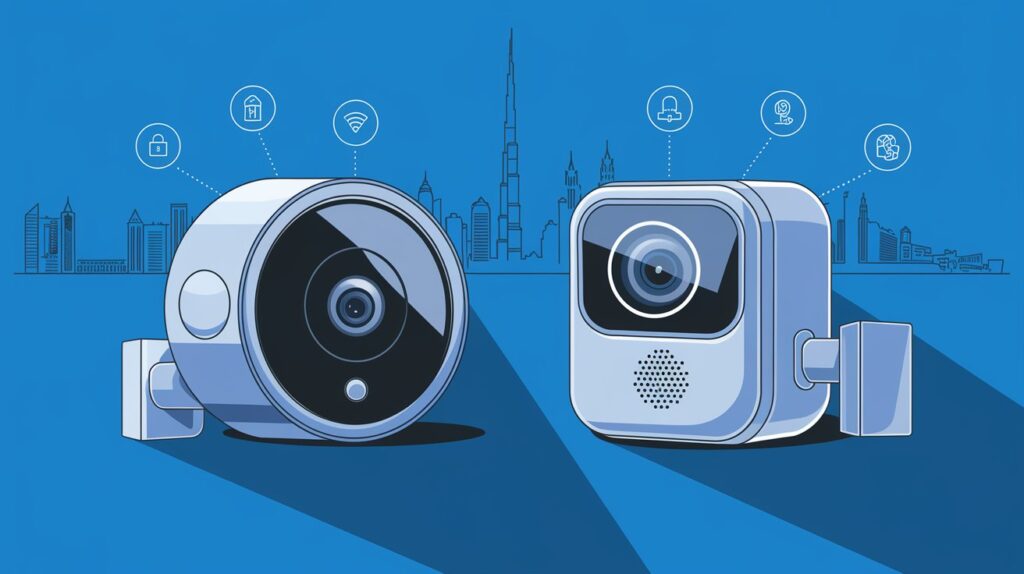With the rise of smart technology, the world of surveillance has evolved significantly over the past few years. CCTV systems, long used as a standard for monitoring and securing properties, have also seen significant advancements. The emergence of smart CCTV systems has raised important questions for homeowners and business owners alike: Should you go for the traditional CCTV system, or is the smarter, more advanced option the better choice?
In this article, we will compare Smart CCTV and Traditional CCTV to help you understand the pros and cons of each system. We will break down key differences, including ease of installation, features, reliability, and cost, to help you make the best decision for your security needs.
What is Traditional CCTV?
Traditional CCTV systems have been used for decades to monitor properties, whether residential or commercial. They are often referred to as analog CCTV systems because they rely on analog video signals to transmit footage. Typically, these systems consist of cameras that feed video footage to a Digital Video Recorder (DVR), where the footage is stored.
Traditional CCTV systems are well-suited for those who need a simple and reliable security solution. These systems do not have the advanced features of smart cameras but offer basic surveillance capabilities.
Key Features of Traditional CCTV Systems:
- Analog Technology: Video signals are transmitted through coaxial cables to the DVR.
- Local Storage: Footage is stored on hard drives connected to the DVR.
- Limited Remote Access: Typically, users cannot access footage remotely without additional setup.
- Basic Recording: Records 24/7 or based on motion detection, depending on settings.
What is Smart CCTV?
Smart CCTV systems are the next step in security technology. Unlike traditional analog systems, smart CCTV systems are based on IP (Internet Protocol) technology, which allows video footage to be transmitted over the internet. This enables remote viewing and control of the system, and in many cases, smart cameras come with advanced features like motion detection, facial recognition, and automatic alerts.
Smart CCTV systems are often integrated with smart home or business security networks, which makes them an attractive choice for tech-savvy individuals who want more control over their surveillance system. These systems can be accessed via mobile apps, and many offer cloud storage, making them ideal for those who need flexibility and remote access.
Key Features of Smart CCTV Systems:
- IP Technology: Uses your internet connection to transmit footage, which can be viewed remotely.
- Cloud Storage: Video footage can be stored on the cloud, reducing the need for local storage.
- Remote Access: Allows you to monitor your property from anywhere via mobile apps or a web browser.
- Advanced Features: Smart features like motion detection, facial recognition, two-way audio, and night vision.
- Integration with Smart Devices: Many smart CCTV systems can integrate with smart home or business devices for enhanced security.
Key Differences Between Smart CCTV and Traditional CCTV
When it comes to deciding between smart and traditional CCTV, the differences can be significant. Let’s break down some of the most important factors to consider:
Technology and Connectivity
One of the biggest differences between smart CCTV and traditional CCTV is the technology they use to transmit and store footage.
- Traditional CCTV uses analog signals and relies on physical cables to transmit video to a DVR. This is a stable and reliable system, but it does not have the flexibility and advanced features of smart systems.
- Smart CCTV, on the other hand, uses IP (Internet Protocol) technology, which means footage is transmitted over your internet connection. This allows for easier remote viewing, cloud storage options, and integration with other smart devices.
If you want a CCTV system that can be accessed remotely and integrated with other smart home or business devices, then a smart CCTV system will likely be the better choice.
Ease of Installation
Installation of a CCTV system can vary greatly depending on whether you opt for a traditional or smart system.
- Traditional CCTV: These systems often require professional installation, especially if you have multiple cameras and a large area to cover. The process involves running cables for each camera and setting up the DVR. While it’s possible to install a traditional system yourself, it can be cumbersome and time-consuming.
- Smart CCTV: Smart systems are typically easier to install, particularly for those who are tech-savvy. Wireless models require fewer cables and can often be installed by the homeowner. However, some systems may still require professional installation, especially for more complex setups.
If you’re looking for a DIY-friendly option and don’t want to deal with extensive wiring, smart CCTV systems may be the better choice.
Video Quality
While both smart and traditional CCTV systems can capture video footage, the quality of the footage often differs between the two.
- Traditional CCTV: Most traditional CCTV systems offer lower video resolution, typically around 720p or 1080p. While this is sufficient for general surveillance, it might not provide the level of detail needed for identifying individuals or reading license plates from a distance.
- Smart CCTV: Smart CCTV systems typically offer higher video resolution, such as 1080p or 4K. This means clearer footage, which is essential for tasks like facial recognition, license plate identification, and high-quality evidence collection.
If image quality is important to you, particularly for applications that require close-up details, smart CCTV is the better choice.
Storage Options
Storage is another key area where smart CCTV and traditional CCTV systems differ.
- Traditional CCTV: Video footage is stored on hard drives connected to the DVR. The amount of storage depends on the size of the hard drive, and once the storage is full, the system will overwrite old footage. This can be a drawback if you want to keep footage for an extended period or if you have a large number of cameras.
- Smart CCTV: Many smart systems offer cloud storage, which allows you to store footage off-site. This eliminates the risk of losing footage due to hard drive failure or theft. Some smart systems also offer local storage options, such as SD cards or NVRs (Network Video Recorders), depending on the system configuration.
If you prefer having the flexibility to store footage off-site and avoid running out of local storage, smart CCTV systems with cloud storage are a superior option.
Advanced Features
Smart CCTV systems come equipped with a variety of advanced features, while traditional systems tend to be more basic.
- Traditional CCTV: Typically offers features such as continuous recording, motion detection, and basic video quality. Advanced features like facial recognition or license plate recognition are usually not available in traditional CCTV systems.
- Smart CCTV: These systems often include a range of advanced features such as:
- Motion detection alerts: Get notified when movement is detected.
- Facial recognition: Identify people who have been captured on camera.
- Two-way audio: Talk to visitors or intruders directly through the camera.
- Integration with smart devices: Link your CCTV system to smart lights, alarms, or door locks for added security.
For those who need advanced surveillance capabilities or want more control over their system, smart CCTV is the way to go.
Cost
The initial cost of a CCTV system can vary greatly depending on whether you choose a traditional or smart system.
- Traditional CCTV: These systems are generally less expensive upfront, especially for basic models. However, you may need to budget for professional installation, additional storage devices, and maintenance.
- Smart CCTV: Smart systems tend to be more expensive due to the advanced technology and features they offer. However, they come with the added benefits of cloud storage, higher-quality video, and easier remote access. Over time, the ability to integrate smart devices may also save you money on other security-related costs.
While the upfront cost is generally higher for smart CCTV systems, they offer greater value if you need advanced features and flexibility.
Which CCTV System is Right for You?
Choosing between smart CCTV and traditional CCTV depends on several factors, including your security needs, budget, and technical expertise. Here are some recommendations to help guide your decision:
- Traditional CCTV may be the right choice if:
- You need a simple and reliable system.
- You have a smaller budget and are okay with basic video quality.
- You don’t need remote access or advanced features.
- You prefer a wired system for stable video transmission.
- Smart CCTV may be the better choice if:
- You want higher video resolution and advanced features like facial recognition or motion alerts.
- You prefer the convenience of remote access and cloud storage.
- You are looking for a system that integrates with other smart devices.
- You’re comfortable with the upfront cost and are willing to invest in a more flexible, feature-rich system.
Ultimately, the best choice for you depends on your specific needs and how much you’re willing to invest in securing your property. Consider the factors outlined above, and choose the system that best fits your security goals. Wen Hong can help you find the right solution.

